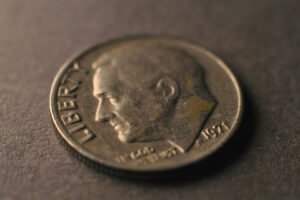
When Brynn Kilpatrick was nine years old, inspired by then 16-year-old Greta Thunberg’s Fridays for Future, she started her own climate vigil on her main street during her grade four lunch period.
Kilpatrick, a friend’s daughter, lives in my hometown in rural eastern Ontario, about 50 miles deep in the great Canadian boreal forest that stretches from Newfoundland to Alaska. Though the old-growth forest there is long gone, logging and lumber trucks still roll by every 15 minutes, and Kilpatrick would watch them as she conducted her quiet protest.
She giggled when she described the man who drove by, giving her “the finger.” When she told her dad, he and others started accompanying her on her vigils. Her dad shook his head, recounting the story five years later: “I am standing with my daughter, it’s about the third week, and I couldn’t believe these men would be yelling and screaming and giving the finger to a nine-year-old,” Bill Kilpatrick said. “Who does that?”
These incidents are part of a larger trend of anger, aggression, and violence directed at young climate activists. And those who are female or queer face the greatest threats for their work for climate justice.
Threats to Women and Girls
In India, three days after 10-year-old Licypriya Kangujam protested air pollution in Delhi by standing in front of the president’s house with a placard, the police came to her parents’ house and she was detained. When Kangujam was 12, she was again detained by UN security when she walked onto the stage at COP28 in Dubai holding a handmade poster that read “END FOSSIL FUEL SAVE OUR PLANET AND OUR FUTURE.”
At the climate conference, the Associated Press and others reported that a record number of access badges were given to oil lobbyists (2,500), while conference access for climate activists was restricted. The Guardian reported that 160 access badges were given to climate-change deniers, while the BBC reported that women made up less than 35 percent of the participants.
Yet the World Bank reported that women are 14 times more likely to be harmed during a climate crisis. In food or water shortages and in housing emergencies sons tend to be given preference over daughters and husbands over wives. Girls are often taken out of school to work or to marry. And when fleeing climate disasters, men at times leave women and children behind.
According to the World Bank, climate change will force 216 million people to migrate by 2050. The majority of these will be women and children. Migrating leaves them vulnerable to sexual assault, exploitation, and sex trafficking. We know this, yet a 2020 UN draft resolution highlighting the vulnerability of women in the climate crisis did not pass the UN Security Council voting procedure.
The Danger to Queer Activists
Seventeen-year-old Mazimpaka Moyo from the Democratic Republic of Congo (DRC) discovered his apartment trashed when he returned home after a night out with friends. In 2023, Moyo had led an anti-fossil fuel protest at Lake Kivu. Below the lake is a large natural gas deposit which the Congolese government recently sold to Symbion Power and Alfajiri Energy. In photos Moyo texted me of his apartment, homophobic slurs and threats of violence are spray-painted on the walls.
Gay, trans, and nonbinary people are also often excluded from temporary shelters during a climate crisis.
Moyo told me he remains in the closet as it is too dangerous to be openly gay in the DRC. Homosexuality remains illegal in 64 countries, including more than 20 African countries. Moyo had already been forced to move once before due to being a queer climate activist.
Meanwhile, Philippines-based Vhon Tobes became a climate activist in grade eight. “We had someone from the government come to talk about the environment,” Tobes said in a Zoom interview. “He told us everything was going to be fine and the government was doing a good job protecting us. Then Yolanda (Typhoon Haiyan) hit my island. It was the biggest typhoon ever to hit the Philippines. It killed more than 6,000 people. That was in 2013. I realized it was all disinformation. Now I am in university, fourth year, and I know more than 20 people who have been murdered for being climate activists. It is very dangerous to be queer and a climate activist here.”
Tobes described being a queer activist as incredibly isolating. “You are told to be quiet. You will be punished for being gay. You will be punished for being an activist. Our communities are not on the side of oppression, but everyone knows the government coordinates with the police and the military to silence activists.”
He had received an anonymous email showing he was being monitored, including a list of every email he had sent or received over the past three months. The email also informed him he had been “red tagged”—a surveillance tactic the government uses to suppress activists and dissidents. “It had all my climate activism, my queer liberation, my support for the Palestinian people,” Tobes said. “It was all there. They were letting me know that I am being watched. The Philippines is one of the most dangerous countries to be an activist in. But what else are we to do? So many intersections of oppression happen in the climate crisis. Activism is about survival.”
Even in America, young climate activists, particularly activists of color and those who are queer, are not safe. In Atlanta, Tortuguita, a 26-year-old Indigenous queer and nonbinary environmental activist, was shot by police while they were sitting in their tent at the “Defend the Weelaunee Forest” protest. Eighty-five acres of the Weelaunee are slated to be destroyed to make way for a new police training center. On January 18, 2023, state troopers entered the activists’ encampment.
An autopsy report noted that Tortuguita had been shot 14 times while sitting in their tent.
This vulnerability to violence is also reflected in Eve Ettinger’s coverage of community resistance to the Mountain Valley Pipeline in Virginia. Ettinger highlights how queer activists have always been on the frontlines of protesting social injustices and are among the most exposed.
Sign up for our free newsletters
Subscribe to NPQ's newsletters to have our top stories delivered directly to your inbox.
By signing up, you agree to our privacy policy and terms of use, and to receive messages from NPQ and our partners.
Officially, four climate activists a week are assassinated somewhere in the world.
The 2SLGBTQ+ community (which stands for Two-Spirit, Lesbian, Gay, Bisexual, Transgender, Queer or Questioning) is already more likely to be financially and socially marginalized in their communities, making them even more vulnerable to a climate crisis. They experience higher rates of homelessness, increased levels of poverty, and increased exposure to violence. Greenpeace notes that gay, trans, and nonbinary people are also often excluded from temporary shelters during a climate crisis.
However, it wasn’t until 2020 that FEMA first acknowledged the 2SLGBTQ+ community exists. In its annual National Preparedness Report on climate disasters, FEMA acknowledged that “identification with a historically disadvantaged group—including minorities and the lesbian, gay, bisexual, transgender, queer (LGBT+) community—are all factors that can increase vulnerability.” The report went on to stress to federal agencies that all Americans have civil rights protections.
Unreported and Unpunished Violence
Officially, four climate activists a week are assassinated somewhere in the world. But the vast majority of violence against climate activists goes unreported and therefore unpunished. As Alessandra Bergamin recently reported, nearly half of all activist killings in 10 “hot spot” countries are state executions.
“State fascism is getting worse,” noted Philippines-based Tobes. “We have troops on campuses now. The universities are not allowed to fund campus groups the government disapproves [of].”
The climate crisis also impacts extremism, according to the European Union’s Counter-Terrorism Coordinator who, in a 2024 paper, notes that “climate change and environmental concerns feature in the ideologies of terrorists/violent extremists.” The paper was not concerned with “peaceful environmental protest and non-violent civil disobedience” but rather, “limited signs of violent radicalisation in the wider environmental activist scene.” But according to the BBC, more and more climate activists are now being referred to the United Kingdom’s Prevent anti-terrorism program following their participation in environmental actions, including lawful protests.
In the United States the FBI has been openly branding environmentalists as domestic “eco-terrorists” since at least the 1990s.
Throughout the world, violence against climate activists is on the rise, with the murder of environmental activists doubling in the past 15 years. At the forefront of this violence is mining, agribusiness, and logging. And while there is a global conviction rate for homicides of over 40 percent, that number drops to 10 percent for murders of climate activists.
“People can’t imagine what change will look like and just want things to stay the same.”
In the Philippines alone, 281 climate activists have been killed in the last decade. With more than 25 activists killed per year, the Philippines, Brazil, and Colombia are now in a legal definition of warfare against climate activists. “But how are we to be heard,” Tobes asked, “when the Northern media picks who the climate leaders will be? Greta Thunberg is great, but she can’t represent what is happening here. I’ve seen so many people die. Yet, we get no attention from the Northern media. The media focuses on Greta, and we literally disappear.”
Tobes noted with frustration, “I have been asking for a pass to go to COP for the last five years, and I keep getting rejected. Power is completely monopolized.”
The Next Generation
Rather than criminalize climate activism, Michel Forst, the UN’s Special Rapporteur on Environmental Defenders, calls for states to address the root causes of the climate crisis, stop criminalizing environmental activism, stop using climate activists as an excuse to curtail democratic rights, comply with their international obligations, and stop restricting civic space for climate conversations.
Brynn Kilpatrick, now a teenager, has ceased her climate vigils. “I’m not doing them anymore,” she told me. “I don’t like to talk about it.”
“I’ve thought about it a lot since Brynn stopped,” her father said. “It’s a pretty complicated anger, [the] anger at a girl for being assertive. People wanted to know why she wasn’t in school. You see this denial about climate change—they don’t want a kid throwing it in their face. People can’t imagine what change will look like and just want things to stay the same.”
In an Instagram post, Tobes spoke to the depression that comes from being on the frontlines of the climate crisis. “I no longer know how to take it all in. I don’t know what to feel. I don’t know what to do.”
In our interview, he concluded, “I’m going back to focus on the local. We need to start holding schools accountable for climate education. We have to focus on widespread mass climate education. The Global North must be pressured into giving climate reparations to the Global South [so] we can educate the people and begin moving away from resource-extraction economies of poverty. The more people know, the more they will resist.”








